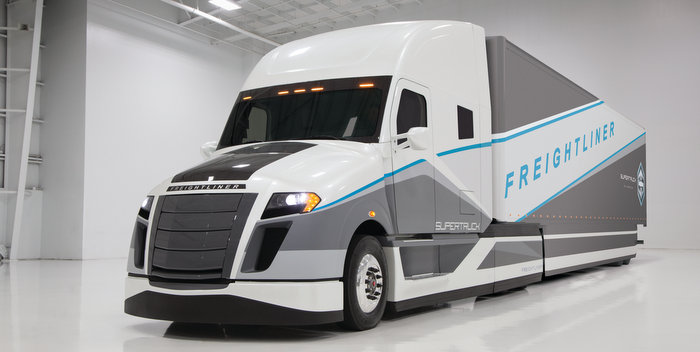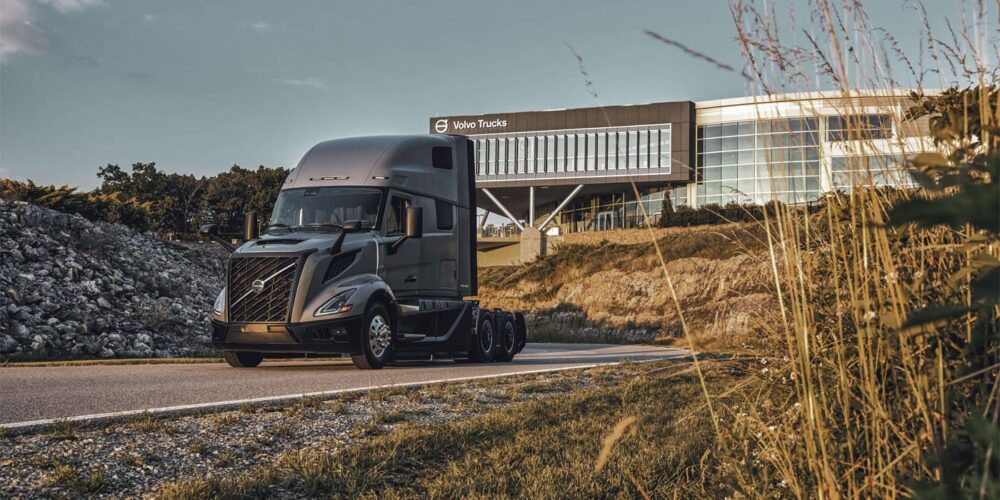The objective of the 2012 Department of Energy (DOE) SuperTruck program was to develop tractor-trailers that were 50% more efficient than the 2009 baseline models by 2015. What truck OEMs have learned—and put into production—during that process is that truck technology development is surpassing original expectations. So here’s an update from one truck OEM.
Applied technology
Derek Rotz, director of advanced engineer for Daimler Trucks of North America (DTNA), talks about how new technology developed for DTNA’s SuperTruck has made its way into the Freightliner Cascadia Evolution over the past several years. As technology developed from 2010 during the SuperTruck R&D process, he says that some technologies have been integrated into production.
“There are a couple of examples: In the 2013 Cascadia Evolution package, there are a lot aerodynamic enhancements there,” Rotz notes. “The SuperTruck didn’t create the parts, but studies we did during the program identified areas of potential. For instance, we now have integrated Detroit powertrain, which includes direct-drive, downsped strategies that were originally developed for the SuperTruck. From our estimates, we believe in the near future you can expect to see 60% [over the baseline of 2009] of the technology benefits from the SuperTruck trickle into product.”
Can’t get enough columns and features from Carol Birkland? Click here to read all her articles.
The spirit of the program was to look at high-risk, high-reward technologies that pushed the envelope. “The SuperTruck’s 50% improvement target was aggressive and a bit daunting,” Rotz admits. “We began by analyzing what we were going to do. As an example, we wondered if we needed a bullet-shaped aerodynamic truck or make minor modifications to the Cascadia. In the end, our SuperTruck design fell somewhere in the middle—based on a modified Cascadia platform. Along the way, we made changes to the cab structure; we bumped out the windshield angle a few degrees for additional aero benefits and modified the cooling package, which was rotated by 20º, to give the hood a more aerodynamic slope, just to name a few of the modifications.”
Adding the trailer
“Going into the SuperTruck project we assumed it would be a 50/50 split of tractor-to-trailer aerodynamic benefits,” Rotz says. “We spent two-thirds of our time focusing on the tractor and one-third on trailer aerodynamics. We were surprised to see that about two-thirds of the aerodynamic improvement came from the trailer and half from the tractor. I attribute that to the decades of aerodynamic enhancements made to tractors, without many changes on trailers being made within the same period, which leads me to believe we’re missing out by not having an integrated approach.”
DTNA exceeded the SuperTruck program goal by achieving 115% freight efficiency, but Rotz says the individual pieces didn’t add up to that.
“When you improve aerodynamics, you reduce drag and the horsepower needed to push down the road simultaneously and you see a benefit,” he says. “We looked engine improvements—when you make enhancements you see improvements. Then we considered downspeed and downgrade strategies on an efficient SuperTruck where less horsepower is needed. By matching the engine to the vehicle, a third benefit emerges, which we are actually not getting credit for by not having a joint regulation for both tractors and engines.”
At this point in time, the current aerodynamic solutions for trailers are sideskirts (mandated in some states) and boat-tail extensions at the back of the trailer.
Closing the gap
When talking about tractor/trailer aerodynamics the conversation often leads to the closing the gap between the tractor and trailer—and the best ways to mitigate airflow. Rotz contends that there is an opportunity for the industry to come up with a joint solution. The technologies currently available for tractors are fairly expensive. One option is a movable fifth wheel, but that might cause problems with axle loading. There are also dynamic side extenders, but they are very expensive as well.
For fleets, the big question is this: Are the technologies providing benefits? As fleets add more technologically advanced trucks into the mix, they need to consider how their operations will be impacted. One of the big concerns is bringing drivers up-to-speed; driver training is key. Rotz adds that DTNA is well aware of the need for drivers to feel comfortable with new onboard systems, and that DTNA carefully considers user experiences as it designs its trucks. “New systems need to be enjoyable, predictable and easy for drivers,” he says.














